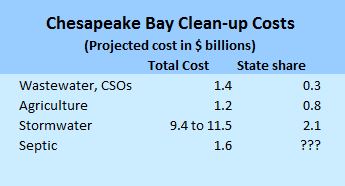by James A. Bacon
Two years ago Clyde Cristman made a presentation to the Senate Finance Committee estimating how much it would cost to meet Virginia’s Chesapeake Bay watershed clean-up goals. Some of the costs were reasonably solid but others, he recalls, “were little better than a wild guess.” The total tab for state government, local government, farmers and property owners: between $13.6 and $15.7 billion.
That document is still being cited as the most definitive report on the subject. “I was hoping that someone would come along and say, ‘Cristman doesn’t know what he’s talking about,” says the legislative analyst. But nobody has.
The biggest wild card is the cost of meeting storm water TDML standards, which Cristman guesstimates will cost between $9.4 billion and $11.7 billion. (TDML stands for maximum allowable Total Maximum Daily Load of nitrogen, phosphorous, sediment and other pollutants.) While the Virginia Department of Transportation will be liable for about $2.1 billion, the rest will fall upon local governments.
By 2014 all governments in Virginia are required to put storm water programs into effect, says Larry Land, director of policy development for the Virginia Association of Counties. There’s still a lot of uncertainty. Between the Chesapeake Bay Preservation Act, the Clean Water Act, the Virginia Storm Water Management Act, an Obama administration executive order and the shift in state oversight from the Department of Conservation and Natural Resources to the Department of Environment Quality, he says, “it gets so entangled, it creates a confusing milieu.”
One thing that seems likely is that localities will get slammed by new financial obligations , however large, at the worst possible time. The $14-15 billion clean water bill comes due just as local governments are being forced to shoulder in $15.2 billion in unfunded pension obligations.
The sums are so large that it is difficult to imagine paying for them out of general funds. “There are a lot of localities that don’t have a clue” how they will handle the situation, says Cristman. Many may feel compelled to institute new taxes or user fees.
There are two obvious models in Virginia. The City of Richmond has imposed a tax on property owners that varies according to the size of the property and the amount of runoff-causing impervious surface. That tax funds a special storm water utility, which uses the money to fund everything from rain gardens and permeable alleys to the de-clogging of ditches that cause flooding. By contrast, Fairfax County lumps its charge into it property tax assessment. However, Christman says
Bacon’s bottom line: As Bacon’s Rebellion readers know, I strenuously oppose most taxes. But I’m open to the idea of a storm-water utility fee in my home jurisdiction of Henrico County, and I think it ought to be structured like Richmond’s. Responsibility for repairing our rivers and streams should fall upon the people causing the problem, not the general population. Homeowners would pay a modest fee while businesses — especially property owners with large parking lots — would pay the most. Fees should be structured so that property owners have incentives to reduce the amount of permeable surface or install Best Management Practices such as vegetative buffers. Additionally, developers should be rewarded for low-impact development — something the county could encourage by eliminating its minimum-parking mandates.
While charging a storm-water tax may be the best solution from an economic perspective, that won’t make it any easier for city councils and county boards that have to break the news to voters. There will be much wailing and gnashing of teeth, especially in localities that choose to raise taxes to fund their pension liabilities.
It’s going to be a rough couple of years.
Update: The situation may not be as dire as portrayed here. The state has set up a fund, reader Ann Cunby tells me, that provides a 50/50 match to help localities meet the TDML guidelines. To find out more about the Stormwater Local Assistance Fund, click here.



